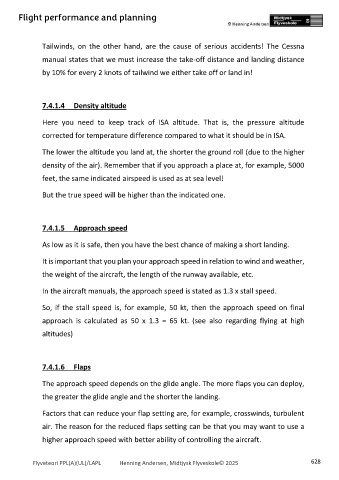Page 628 - PPL-engelsk 2025
P. 628
Flight performance and planning
Tailwinds, on the other hand, are the cause of serious accidents! The Cessna
manual states that we must increase the take-off distance and landing distance
by 10% for every 2 knots of tailwind we either take off or land in!
7.4.1.4 Density altitude
Here you need to keep track of ISA altitude. That is, the pressure altitude
corrected for temperature difference compared to what it should be in ISA.
The lower the altitude you land at, the shorter the ground roll (due to the higher
density of the air). Remember that if you approach a place at, for example, 5000
feet, the same indicated airspeed is used as at sea level!
But the true speed will be higher than the indicated one.
7.4.1.5 Approach speed
As low as it is safe, then you have the best chance of making a short landing.
It is important that you plan your approach speed in relation to wind and weather,
the weight of the aircraft, the length of the runway available, etc.
In the aircraft manuals, the approach speed is stated as 1.3 x stall speed.
So, if the stall speed is, for example, 50 kt, then the approach speed on final
approach is calculated as 50 x 1.3 = 65 kt. (see also regarding flying at high
altitudes)
7.4.1.6 Flaps
The approach speed depends on the glide angle. The more flaps you can deploy,
the greater the glide angle and the shorter the landing.
Factors that can reduce your flap setting are, for example, crosswinds, turbulent
air. The reason for the reduced flaps setting can be that you may want to use a
higher approach speed with better ability of controlling the aircraft.
Flyveteori PPL(A)(UL)/LAPL Henning Andersen, Midtjysk Flyveskole© 2025 628

